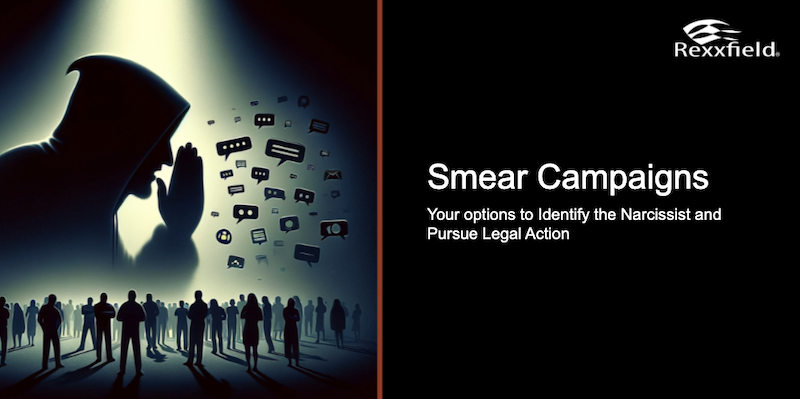Smear campaigns are often malicious, brutal, and entirely unjust toward the target. The person you are dealing with might be a sociopath. Sociopaths have no heart, no conscience and no remorse. And while your first response may be to defend yourself, this approach is almost always ineffective and may even backfire. Smear campaigns can happen through various channels, including email, text messages, online platforms such as social media, word of mouth, or any other communication channels.
Our founder personally survived a smear campaign orchestrated by a narcissist. It was a deeply frustrating and bitter experience that left his business in ruins, staff unemployed, and vendors unpaid. Thankfully, this adversity fueled his ambition to help other victims, and led him to use his expertise in information technology security and digital forensics to create “Rexxfield.” Since 2008, we investigate smear campaigns for businesses and individuals on a daily basis. You can find his reflections on this experience here: Reflections & Advice From a Career Re-builder & Internet Smear Campaign Survivor
When you are the victim of a smear campaign, the first and best response is often to ignore it. But how to respond to a narcissist smear campaign when ignoring doesn’t work?
Identify the Narcissist behind a Smear Campaign
Smear campaigns happen on and through various platforms, including traditional media such as email and phone, but also online platforms such as social media, and other communication channels. The digital evidence related to these activities is often encrypted, protected, or otherwise hidden. Popular communication methods are ProtonMail and spoofing apps. Individuals involved in malicious activities and harassment are usually tech-savvy and may use proxies, VPN services, or the Tor Network to conceal their identities. This makes it challenging to obtain evidence about the antagonist, as even services like Google cannot reveal a user’s real IP address when they are hidden behind such anonymity tools. However, our experienced cyber investigators specialize in tracing anonymous cybercriminals who use VPNs and can uncover their real identities.
If you have suspects, the chance of identifying the individual responsible for the slander campaign outside of court is much more likely. We can effectively rule in or rule out suspects. All our methods are legal, admissible in court, and highly compelling. Once identified, many narcissists will often delete the offending material out of fear of criminal or civil court action. If they persist, the evidence we gather can support you in seeking injunctive relief through litigation or pursuing criminal charges.
 Can You Sue for a Smear Campaign?
Can You Sue for a Smear Campaign?
Requirements for Suing Someone for a Smear Campaign
Disclaimer: We are not lawyers, and the information provided should not be relied upon as legal advice. However, due to our decades of experience in legal assistance and collaborations with attorneys, we have a comprehensive understanding of how defamation lawsuits work. For formal legal counsel, we strongly recommend consulting a qualified attorney.
KRLaw, Minc Law, and Dhillon Law Group are excellent internet defamation firms that we have worked with extensively for years. We confidently recommend them to anyone seeking to pursue legal action against someone responsible for a smear campaign.
To sue someone for a smear campaign, which typically involves defamation, a plaintiff must establish several key elements to recover damages:
- Identification: The plaintiff must demonstrate that the defamatory publication specifically refers to them. It must be clear that the statements are “of and concerning” the plaintiff.
- Publication: The plaintiff must show that the defamatory statements were communicated to at least one third party. Private insults or statements that were not shared with others do not meet this criteria.
- Defamatory Meaning: The plaintiff must establish that the statements in question are defamatory, meaning they must go beyond merely annoying or hurting someone’s feelings. The statements must damage the plaintiff’s reputation in a substantial way.
- Falsity: The statements must be false. Truth is an absolute defense to a defamation claim. The burden of proving that the statements are false generally falls on the plaintiff.
- Statements of Fact: The statements must be verifiable as false statements of fact. This means they can be proven false based on evidence. While expressions of opinion are generally protected, they can imply assertions of objective facts.
- Damages: The plaintiff must show that the false and defamatory statements caused actual harm, such as financial loss, reputational damage, or other specific injuries. Without proving actual damage, the plaintiff cannot recover damages in a defamation lawsuit.
When dealing with a smear campaign, both businesses and individuals have several legal action options to consider. These options can help address the damage caused by false or misleading statements and potentially hold the responsible parties accountable. Here are some common legal actions:
Defamation Lawsuits
Know the differences between defamation, libel, and slander. Defamation is when someone makes false statements that harm a reputation. Libel is written defamation, and slander is spoken defamation. If you can prove that the false statements caused reputational harm and financial losses, you can file a defamation lawsuit.
Cease and Desist Letters
A cease and desist letter is a formal request to the offending party to stop making false statements and to retract any previously made false statements. This is often the first step before pursuing a lawsuit and may sometimes be enough to stop the malicious lies.
Injunctions
If a cease and desist letter doesn’t work, your lawyer can pursue an injunction which is a court order that requires the offending party to stop making false statements.
Compensation Claims
Damages: With a defamation lawsuit, you can ask for monetary compensation for the harm caused by a smear campaign. This can include compensation for lost revenue, damage to reputation, and other financial losses. You will need to provide strong evidence of these losses to the court.
Criminal Charges
Harassment and Cyberbullying: In some cases, smear campaigns may involve harassment or cyberbullying, which can be criminal offenses.
Digital Content Removal
Takedown Requests: For online smear campaigns, you can can request the removal of defamatory content from websites, social media platforms, and search engines. If platforms don’t comply, a court ordered removal request may be necessary.
Anti-SLAPP Statutes
Strategic Lawsuits Against Public Participation (SLAPP): In some jurisdictions, there are laws to protect against frivolous lawsuits intended to silence critics. It is important to be aware of these statutes to avoid counterclaims when pursuing legal action. Know how to avoid dismissal of libel lawsuit under Anti-SLAPP legislation.
Legal Counsel
Engage Attorneys: Legal professionals who specialize in defamation law can provide guidance on the best course of action, represent you in court, and help navigate complex legal procedures.
Pursuing legal action can be a lengthy and costly process, so carefully weigh the benefits and risks.
How to Respond to a Smear Campaign?
Responding to a smear campaign requires a strategic approach to protect your reputation and address the falsehoods effectively.
- Stay calm and Assess the situation: Avoid emotional reactions, as this attention is what the antagonist thrives on. Instead, focus on understanding the extent and impact of the smear campaign by identifying the platforms and individuals involved.
- Documenting everything. Collect all relevant evidence related to the smear campaign, such as screenshots, emails, and messages. Also, make sure to track any losses, such as loss of business or damage to personal relationships, to understand the full impact and prove your losses in court.
- Consult with professionals to guide your response. Cyber investigators can help collect evidence of who is responsible. Lawyers experienced in defamation cases can help you understand your rights and potential legal actions. And public relations experts can help you prepare an appropriate response and manage communications with the public and media.
- Address the falsehoods directly by making a public statement if appropriate. Here it’s important to be factual, concise, and avoid personal attacks. Use evidence to correct misinformation and provide correct information where possible.
- Focus on your reputation by highlighting your achievements, values, and positive contributions to counteract the negative impact. Maintaining professionalism is key to restoring your reputation over time.
- Limit direct engagement with the narcissists, as this fuels their actions. They thrive on your attention, which is why confrontation can escalate the situation. Instead, manage the situation through professional channels. Be careful with your social media presence and avoid sharing personal information that could be used against you.
- Seek support from friends, family, and professional networks to help manage the emotional impact of the smear campaign. Consulting a mental health professional can also provide assistance in dealing with stress and emotional challenges.
- Explore legal options if the smear campaign has caused you significant harm. A lawyer can tell you if it’s worth pursuing a defamation lawsuit or issuing a cease and desist letter to demand the narcissist to stop the smear campaign.
Working with clients who suffer from these smear campaigns, we understand that these are incredibly stressful to deal with, and the emotional toll and potential damage to your reputation can be overwhelming. To support you through this difficult time, we offer free consultations to assess your situation and provide guidance on the best steps to take. We want to help you navigate this process with as much clarity and support as possible, so you understand your options and best next steps.


